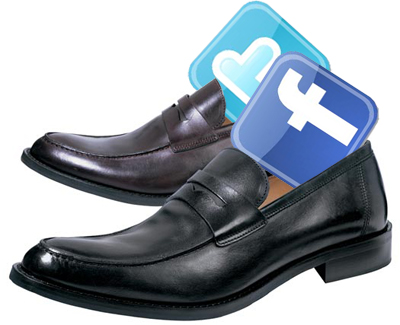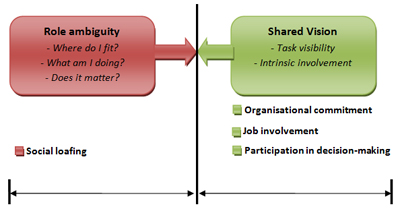Social (media) loafing: Shared vision and the use or ban of social media at work
Do you feel your staff spend excessive work time on social media and non-work related sites? Research tells us that rather than stopping the behaviour (a form of social loafing), you are better off engaging them in a shared vision to give them something to work towards.

Social media at work: good or bad?
In 2007, 50 percent of companies blocked employee’s access to Facebook. Surfing on the job, described as “workplace internet leisure browsing (WILB)”, was prominent in 70 percent of workers in one 2009 Australian study, which also inferred a 9 percent increase in productivity. The productivity increase could be more attributed to the premise behind concepts such as Pomodoro that promote periodic brief breaks rather than continuous effort over long periods for knowledge-intensive tasks. This could explain why another 2009 study found what most managers suspect: a 1.5 percent decrease in productivity by employees who frequent Facebook at work.
The amount of activity appears to have remained steady, with another 2010 study continuing to show the one-third ratio of Australians spending at least one hour on Facebook while at work. Banning the sites only seem to promote an adversarial relationship, spawning sites here and here explaining how to get around workplace bans. Social media professionals speak out against the practice and even create Facebook groups that decry the practice. Given the 15 members in the group since it was established in 2008, I would say bans are incredibly effective or no one cares.
Surfing as an expression of social loafing, countered by a shared vision

Like so many aspects of organisational development, what we see is often not the issue. The question is not whether the person is spending excessive time on non-work related sites, but why. Specific to a team situation, surfing can be seen as a form of social loafing, defined as “the phenomenon of people making less effort to achieve a goal when they work in a group than when they work alone”. A primary contributing factor is role ambiguity, where individuals question: 1) where they fit, 2) what they are meant to do, and 3) why it matters.
Shared vision is a key weapon against social loafing. Shared vision describes a collaborative process with the team to define and attain an end objective. Aspects critical to a shared vision are task visibility and involvement. Just as social loafing is a result of role ambiguity, so also do we see that organisational commitment, job involvement, and participation in decision-making result from a shared vision.
The key point is this: A propensity to spend time on non-work related sites is a result of a lack of engagement with organisational vision. Blocking websites will only redirect the lack of engagement into other behaviour, which may be leaving your organisation.
Alternatively, engaging individuals in a shared vision that is visible and attainable will invariably result in a reduction of the undesirable behaviour. Understanding this paradigm is critical to your response:
- Telling staff to stop behaviour will not tell them what they should be doing.
- Empowering staff to tell you what they should be doing to achieve your shared vision will leave little room for anything else.
Practical application: If it matters, measure
All that said, disengagement happens to the best of us. I am not immune to the afternoon lull, as the soft chirp of Tweetdeck or the group Skype chat bell pull me from tasks I would rather avoid. I am often not aware of my distraction until after being sucked in.
I also acknowledge the necessity of those working in knowledge industries needing to stay up to date. Again, the challenge is that a foray into the beta Flash Player can result in performing QA on a wide assortment of games and videos. Being aware of how long I spend “researching” would help me manage my time.
My team and I share common beliefs: none of us want me to monitor their browsing. I have a day job, and do not see looking over the shoulder of responsible and professional adults as part of that job. I do see my role as serving my team to allow them to make the best decisions possible to achieve shared outcomes.
As we all agree towards outcomes of efficiency and effectiveness, I would rather ensure each of us is aware of the time we spend on non-work related sites. Practically, this could mean an indicator on each individual’s dashboard showing the amount of time they spend on non-work related sites. We could also show the five day average of the studio. The dashboard also shows progress towards common objectives of task completion. This future implementation is based on a premise of making each person responsible for what they are accountable for.
We are a digital company, and spend a fair amount of time actually developing in Facebook. Our goal would never be to have the time be zero. However, research shows that with a compelling shared vision of the future and ownership of each of our behaviour, the number will stabilise to a level we all agree is acceptable.


1 thought on “Social (media) loafing: Shared vision and the use or ban of social media at work”
Comments are closed.